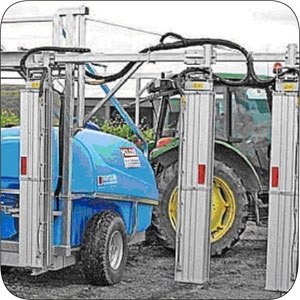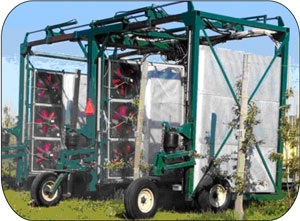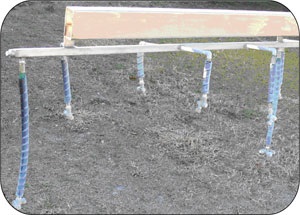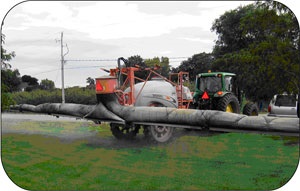Pesticide drift from ground applications
Information on the causes of spray drift, ways to reduce spray drift, key steps if pesticide drift is suspected and the legal responsibility of those who spray pesticides.
ISSN 1198-712X, Published January 2011
This fact sheet explains causes of spray drift, ways to reduce spray drift, key steps if pesticide drift is suspected and the legal responsibility of those who spray pesticides.
Introduction
Pesticide drift is the aerial movement and unintentional deposit of pesticide outside the target area. There are two forms of pesticide drift.
- Particle drift is the movement of pesticide droplets or solid particles outside the area being treated. Coarser droplets move short distances and fall close to the point of release. Finer particles (i.e. less than 200 microns) can remain suspended on air currents for long periods of time and can be carried far outside of the target area. For example, a 100 micron droplet takes 11 seconds to fall three metres in still air, and will drift more than 20 metres in an 8 km/h wind.
- Vapour drift is the movement of pesticide vapours outside the area being treated. Vapour drift is invisible and can have a considerable impact. Vapours are created when spray droplets evaporate both at the time of application and for some time after the spray has dried on plant or soil surfaces. The potential for vapour drift is more a product of the volatility of the active ingredient, the formulation (for example, esters) and environmental conditions (for example, hot and dry) than the equipment used.
Why be concerned about drift?
The potential impact of pesticide drift includes:
- less product being deposited on the target, resulting in reduced efficacy
- financial loss associated with wasted pesticide and time
- the risk of injury or damage to human health, susceptible plants (for example, adjacent crops), non-target organisms (for example, wild and domestic animals, pollinating insects), the environment or property (see Figures 1 and 2).
There are also legal responsibilities and liabilities associated with all these issues.
All spray operators need to be concerned about pesticide drift and must make efforts to mitigate drift in all forms. While some level of drift either during or after an application will always occur, understanding the factors that affect it can minimize its effects.
Factors affecting drift
The factors that cause drift are a combination of:
- environmental conditions
- spray practices and, to some degree
- the pesticide's physical and chemical properties.
The key environmental conditions are: wind velocity and direction, temperature and relative humidity. The most important spray practices involve the spray quality produced by the sprayer, the distance between nozzle and target, and the travel speed of the sprayer. Each factor is described below.
Environmental conditions
Wind velocity and direction
Air movement will always result in some spray being carried outside the target area. The amount of spray drift increases significantly with increasing wind speeds. To minimize drift:
- spray when wind speeds are light to moderate and moving away from sensitive environmental areas
- never spray during periods of dead calm because spray remains suspended in the air until the wind changes and potentially carries it off-target
- change sprayer settings if the wind increases during spraying or halt the job until conditions improve. High or changeable wind not only increases the chance for drift, it may also compromise the application by making coverage inconsistent.
See Table 1 for general spraying recommendations related to wind conditions. Visible indications, such as the movement of smoke or rustling of leaves, only provide general guidance. Use a proper wind gauge when spraying to measure and record wind speed at the level of spray release.
| Wind condition | Wind speed | Description | Visible signs | Spraying |
|---|---|---|---|---|
| Still | 0–2 km/h (0-1.25 mph) | May lead to vapour drift where finer droplets remain suspended in the air, prone to evaporation and drift long after spraying is completed | Smoke rises vertically | Do not spray |
| Gusty | Not applicable | Wind direction is unpredictable and may indicate an inversion | Direction keeps changing | Do not spray |
| Light air | 2–3.2 km/h (1.25–2 mph) | Suitable for spraying | Direction shown by smoke | Spray |
| Light to gentle breeze | 3.2–9.6 km/h (2–6 mph) | Ideal for spraying | Leaves rustle, wind felt on face, twigs in motion | Spray |
| High wind | 9.6–16 km/h (6–10 mph) | Higher wind speeds pose the most obvious risk of drift through, around or over the target | Small branches move, raises dust | Spray with caution or do not spray |
Temperature and relative humidity
In general, do not spray when relative humidity is lower than 40 per cent and air temperature is above 25°C. This improves target coverage and reduces the chance of drift due to temperature inversions or evaporation.
Do not spray during periods of dead calm. These periods may occur in early morning or late evening, when the temperature is usually cooler and the relative humidity is typically higher. This combination of factors can result in drift-sized droplets staying in the field. When the wind picks up, these spray droplets can move away from the target area, possibly causing injury to adjacent non-target areas. This is of particular concern with certain herbicides when they drift onto sensitive neighbouring crops.
Hot and dry conditions increase drift because droplets rapidly evaporate and become fine droplets, vapour or particles of concentrated pesticide. On hot days the land also warms, giving rise to upward convection currents that carry droplets above the crop canopy during spraying. Lateral air movements then transport these particles as far as several kilometres from the target area.
Spray practices
Spray quality
Hydraulic nozzle tips are classified by their spray patterns, flow rates and average droplet size; this is called "spray quality". When the operating pressure changes, the average droplet size also changes. For example, a nozzle that produces a medium spray at low pressure would produce a finer spray when pressure is increased.
Generally, finer droplets provide better coverage but are more likely to evaporate and drift. They slow down quickly once they leave the nozzle opening, take a much longer time to get from the nozzle to the target and do not penetrate dense canopies without air assistance. Coarser droplets resist evaporation and, because they have more momentum, are not easily deflected by wind. But they are more likely to bounce and run off the target and provide less coverage.
Consider these two options carefully when selecting nozzles, operating pressures and travel speeds.
Droplet size classification
The droplet size classification system (very fine to extremely coarse) uses "volume median diameter" (VMD), which is a manufacturer's term to describe the average droplet size produced by a nozzle (see Table 2). This system was developed for flat fan nozzles spraying into still air under specific conditions and should not be used to classify cone-pattern nozzles, such as those produced by disc-core or disc-whirl nozzles. Generally, cone-pattern nozzles produce finer particles than most flat fans used in horticulture because they operate at high pressure, encounter shear from air assistance and are sprayed over larger distances.
| Classification | Volume median diameter (microns) | Description |
|---|---|---|
| Very fine | <100 | Highly susceptible to drift — not advised. |
| Very fine/fine | 154 | Attaches to under-leaf surfaces, but tends to remain in the air. |
| Fine/medium | 241 | Lands on stems and narrow leaves. |
| Medium/coarse | 356 | Lands on large flat surfaces, like broadleaf weeds, but may bounce. |
| Coarse/very coarse | >451 | Wind tolerant, but will run off crop. |
Distance between nozzle and target area
Once released, spray droplet size decreases rapidly through evaporation and/or volatilization. As the release height above the target or crop canopy increases, the potential for spray drift also increases. The same holds true for the distance between an airblast nozzle or vertical boom and the target.
Computer-generated modeling
See the impact droplet size and environmental conditions have on particle drift. Developed by researchers with the United States Department of Agriculture, "DRIFTSIM" is an easy-to-use computer program that predicts drift distances of spray droplets under a wide variety of conditions.
Pesticide's physical and chemical properties
Formulation and adjuvants
While drift-reducing adjuvants are available, check to ensure they are compatible with the pesticide in use. If not compatible, they can change the spray quality. This could damage the crop, make coverage uneven and/or reduce canopy penetration. Test a small area before adopting on a large scale. As well adjuvants can break down and become ineffective when used in tanks with paddle or hydraulic agitation.
It is preferable to use a product already formulated to reduce drift. See Additional Resources at the end of this Factsheet for a list of publications that provide more detail on chemical product recommendations.
For example, low volatility amine formulations of acidic herbicides are less prone to vapour drift while ester formulations have a higher likelihood. If a drift-prone product must be used the product label will include additional precautions. For example, avoid spraying dicamba dimethylamine (a highly volatile amine) during high temperatures, since vapour drift can occur at high temperatures (> 25°C) within one to two days after application. Even the slightest drift from dicamba can cause major damage to nearby sensitive crops.
Equipment to reduce drift
There are several ways to minimize the potential for spray drift. Some involve adjusting equipment and others relate to the application method. All require that the spray applicator be both aware of the conditions that promote drift and be willing to make changes while spraying.
Spray equipment
While there are many types of sprayers used in agriculture for the ground application of pesticides, the two most often associated with drift are the airblast sprayer and the horizontal boom sprayer. Minimize spray drift by adjusting these sprayers to produce a coarser spray quality at a minimal effective distance from the target. How to make these sprayer adjustments are outlined below.
Airblast sprayers
An airblast sprayer is a vehicle-mounted or vehicle-drawn device that uses a high-speed stream of air to carry the spray from air-shear or hydraulic nozzle tips into the target. The potential for drift can be reduced by:
- adjusting settings to produce the minimal effective air speed throughout the season. Depending on the crop, air should just move the leaves on the far side of the canopy. Full air early in the season is rarely appropriate
- increasing droplet size by
- using lower pressures (within the range indicated by the nozzle manufacturer)
- using air-induction nozzles or
- switching to disc-core (or disc-whirl) nozzles that produce a coarser spray quality
- using deflectors to channel air into, not over or under, the target (see Figure 3)
- using towers to reduce distance-to-target and direct air into the target (see Figure 4)
- switching to a tangential (Figure 5), recycling (Figure 6), multi-duct (Figure 7), or multi-fan sprayer, all of which reduce off-target deposition
- using foliage sensors that turn boom sections on and off to match the size and shape of the canopy.
Horizontal boom sprayers
A horizontal boom sprayer is a vehicle-mounted or vehicle-drawn device that sprays through a series of nozzles attached to a boom that extends outward on one or both sides. The potential for drift can be reduced by:
- maintaining a minimal effective boom height. This height is nozzle-dependent, but generally 50 cm above the top of the target. Follow nozzle manufacturer's guidelines
- using low-drift nozzles, such as air-induction, drift-guard, turbo tee jet, etc.
- using drop-arms to bring the nozzles closer to the target crop and match the contour of the canopy surface (Figure 8)
- using the appropriate spray angle. Wider spray angle nozzles (for example, 110°) create smaller droplets than nozzles with narrower spray angles (for example, 80°). Although smaller droplets generally increase the chance of drift and reduce penetration in dense canopies, the wider-angle nozzles allow the boom to lie closer to the target
- using air-assist to direct spray into the canopy (Figure 9)
- using shrouds to create physical barriers to drift (Figure 10)
Other categories of sprayer
Some sprayers are not easily categorized and can use a combination of the previously described modifications. Examples of these other sprayer categories include:
- Vertical boom sprayers. Similar to a horizontal boom, but running vertically and used to spray crops such as canes, bushes and trellised vines.
- Boomless sprayers, which use a cluster of nozzles or rotary discs to create the spray pattern. Often the cluster nozzles create large-sized droplets that can reduce spray drift, but the rotary disc can also produce very small droplets and create a drift problem.
- Wiper/wick systems (Figure 11), which make mechanical contact between crop and pesticide by wiping the stems and leaves in the target area. Because there are no spray droplets involved with this method, particle drift is not a problem.
Techniques to reduce drift
There are many techniques to minimize drift when using the equipment previously described. Equipment modification on its own is not enough to reduce incidents of drift. Spray application is only as good as the spray applicator's methods. Review the best practices below to help control drift.
- Use nozzles that produce the desired spray quality while minimizing drift.
- Operate at the minimally-effective distance between the nozzle and the target. Be sure to confirm spray coverage by placing water-sensitive paper in the hardest-to-reach portions of the canopy. Do not operate booms beyond the recommended height or pressure range specified by the nozzle manufacturer.
- Do not use high pressures when making herbicide applications. Lower pressure reduces the proportion of driftable fines.
- Where possible, use products less prone to drift.
- Correct calibration is key to ensuring all nozzles are discharging the correct output with the optimal spray quality. The process of calibration also includes confirming an ideal travel speed, minimal effective distance-to-target and the correct positions for deflectors, air-curtains and shrouds.
- Calibrate at least twice per season or whenever changes are made to the spray equipment.
- Research shows that downwind shelterbelts (also called windbreaks) can greatly reduce pesticide drift. Contact Conservation Ontario to help plan a windbreak project, including the design, sourcing the right tree species and sourcing potential funding.
- When spraying outside rows using an airblast sprayer turn off the outward-facing boom and consider only spraying inward on the last two downwind rows. Be aware that spraying from only one side reduces coverage.
- Driving at a reasonable speed improves canopy penetration and reduces the potential for drift. As travel speed increases, spray can be diverted backwards into upward wind currents and vortices behind the sprayer. This increases variability in spray deposit, which is generally undesirable as it adds to drift. This effect is amplified when driving into the wind because the shearing effect increases the number of driftable fines, even when using coarser droplets.
- Reduce airblast airspeed (particularly early in the season when there is not enough foliage to warrant the extra air) to greatly reduce the potential for drift. To achieve this:
- reduce the power take-off speed (gear up - throttle down)
- use a lower fan gear or
- use a hydraulic motor to drive the fan.
Be sure to confirm coverage using water-sensitive paper and be aware that erratic wind can make spray coverage uneven.
- Develop "Awareness Zones". For established plantings, create a map of the crop and surround it with a 1.0 km spray drift awareness zone. This is not a buffer zone. Survey the awareness zone and identify any sensitive areas that could be affected by spraying: for example, neighbouring sensitive crops, endangered native flora and fauna, waterways and wetlands, foraging bees and sites of human habitation or activity. Prepare site-specific operating instructions (including any of the techniques already mentioned) for spraying near any sensitive area falling within the awareness zone.
For example, notifying neighbouring greenhouse growers of an early morning pesticide application gives them the opportunity to close the vents, thus avoiding the possibility of drift into the greenhouse.
Buffer zones
Generally, a buffer zone is the downwind distance separating the point of direct pesticide application from the nearest boundary of a sensitive habitat (see Figure 12). Look on the pesticide label for any buffer zone requirements.
Health Canada's Pest Management Regulatory Agency has an online spray drift calculator that allows applicators to modify the labelled buffer zones as required by the product label, based on weather conditions, the category of sprayer or droplet size. For more information, see the Buffer Zone Calculator.
Legislation and liability
Anyone using pesticides is responsible for their safe application. Where drift damages adjacent crops, insurance adjustors generally ask the following questions:
- Was the damage to the applicator's own crop? If so, it is unlikely that there will be coverage under any insurance policy.
- Was the damage to a neighbour's property? If so, the applicator's liability policy may respond.
- Was the product being applied according to label directions?
The Pesticides Act requires that licensed spray applicators carry a specialized liability insurance policy that provides appropriate coverage for their business. Operators who work on a "for hire" basis (for example, a licensed spray applicator) or away from their own farm operation will need additional coverage.
A normal farm insurance policy may not cover spraying done by licensed spray applicators or those done in share-cropping arrangements.
It is important to consult with an insurance broker or agent to ensure there is adequate coverage for any type of operation.
Section 29 of the act requires anyone who uses a pesticide that causes an adverse effect to notify the Ministry of the Environment, Conservation and Parks (MECP). Should there be any impairment to the quality of life or environment in the use of a pesticide, charges could be laid against the applicator under Section 4.
Consult the Blue Pages in the local telephone directory or visit the Ministry of the Environment, Conservation and Parks website to locate the nearest district office. After hours, contact the Pollution Hotline at 1-866-663-8477.
What to do if you suspect drift damage
There are a series of steps to follow when damage caused by pesticide drift is suspected.
Diagnose the problem
- Eliminate other possible causes for damage, such as disease, insects, nutrient deficiency, herbicide carryover and environmental stress.
- Herbicide drift, for example, often causes distinct patterns in the affected crop. Greater damage is usually found near the source, diminishing with distance. In contrast, patchy damage is often caused by poor soil pH.
- Confirm there is evidence of a spray application. Look for wheel tracks, weed symptoms, boom patterns and overlap on the headlands. Look for spray evidence in neighbouring fields, lawns and ditches.
Contact the appropriate people
- Talk with neighbours and/or nearby spray applicators. Ask what was sprayed, when it was applied and who performed the application.
- Contact the nearest regional MECP district office or call the Spills Action Centre at toll free: 1-800-268-6060. (Ministry locations are available at on the web or in the Blue Pages of the telephone directory). MECP Environmental Officers can visit the site to take samples of plants and soil for analysis.
- Affected parties should contact their respective insurance adjustors.
Document all details
- Collect spray records for review. This includes products sprayed, environmental conditions during all applications and details about sprayer settings.
- Photograph suspected damage and date each photograph. Do this several times throughout the season.
- Document yield loss from the damaged area and an undamaged area. Choose a similar planting (for example, same age, cultivar, rootstock, etc.). For perennial crops (for example, vineyards, orchards, asparagus, berries) document the effects for several years after the damage occurred.
Conclusion
The methods and materials described in this Factsheet can reduce, but do not eliminate pesticide drift. In areas near sensitive crops, all reasonable precautions must be taken. Follow the pesticide label instructions to mitigate drift. Extremely low, and often invisible, amounts of spray drift can be very damaging to sensitive crops or habitats, so it is essential to know and follow both the pesticide label and the manufacturer's directions for proper use of the spray equipment.
Additional resources
- Best Management Practices: Pesticide Storage, Handling and Application
- Ontario Pesticide Education Program: Grower Pesticide Safety Course Manual
- OMAFRA fact sheet, Six elements of effective spraying in orchards and vineyards
- OMAFRA fact sheet, How weather conditions affect spray applications
- OMAFRA fact sheet, Calibrating airblast sprayers
- OMAFRA fact sheet, Adjusting, maintaining and cleaning airblast sprayers
- Ontario Crop Protection Hub
- Publication 848: Guide to Ginseng Production
- Publication 841: Guide to Nursery and Landscape Plant Production and Integrated Pest Management
This fact sheet was authored by Dr. Jason S.T. Deveau, Application Technology Specialist, OMAFRA, Simcoe, and Denise Beaton, Crop Protection Lead, OMAFRA, Guelph. Kristen Callow, Weed Management Lead, OMAFRA, Ridgetown, Leslie Huffman, former Apple Specialist, OMAFRA, Harrow, Mr. John Purdy, private consultant, Mr. Robert DeBrabandere, farm claims specialist and staff of both the Ministry of the Environment and the Ontario Pesticide Education Program made valuable contributions.











